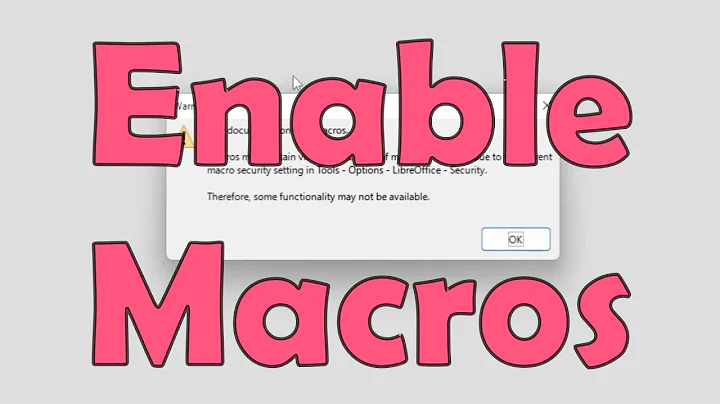How do I run a LibreOffice macro from the command line without the GUI?
The problem is that even though LibreOffice is invisible when started, it becomes visible after opening a document. There is a solution at https://forum.openoffice.org/en/forum/viewtopic.php?f=5&t=22548:
-
Run LibreOffice headless to call a macro. The command line call should not specify the document to open, just a macro. For example (using the newer macro syntax):
soffice -headless -invisible "vnd.sun.star.script:Standard.Module1.MySubroutine?language=Basic&location=application" -
The macro calls loadComponentFromUrl with the
Hiddenproperty set to true. This will cause the document to not become visible. -
Now the macro performs whatever it was going to do with the document.
EDIT:
To make it work for different files, pass the filename as a parameter using the older macro syntax. An example from https://forum.openoffice.org/en/forum/viewtopic.php?f=20&t=8232:
soffice "macro:///Library3.Module1.test_Args(arg1,123,4.567,2000-12-31)"
Related videos on Youtube
dimpol
Updated on September 18, 2022Comments
-
dimpol over 1 year
I want to run a LibreOffice macro on .odt file(s) from the command line. Because I want to scale this up to applying the macro to multiple files, I don't want the GUI to pop-up in each execution of the macro.
I currently have a working macro (that also closes the file at the end) and as far as I can find, I should be able to call it as followed:
soffice --invisible --nofirststartwizard --headless --norestore "D:\myFolder\my file.odt" "macro:///Standard.Module1.myMacro"or
swriter --invisible --nofirststartwizard --headless --norestore "D:\myFolder\my file.odt" "macro:///Standard.Module1.myMacro"Both commands execute the macro correctly, however the GUI opens and closes during execution. How do I prevent this?
I am working on a Windows 10 Computer and Help>About LibreOffice gave the following info:
Version: 5.2.1.2
Build ID: 31dd62db80d4e60af04904455ec9c9219178d620
CPU Threads: 4; OS Version: Windows 6.2; UI Render: default;
Locale: en-US (en_US); Calc: CL-
Máté Juhász over 7 yearsin short: YOU CAN'T. You can't run macros without opening the application. However, you probably can hide the application window during the run of the macro, I don't know openOffice, but in MS Excel it would be
Application.Visible=False -
dimpol over 7 yearsThat makes sense, however I hoped the --invisible or the --headless flag would do exactly that.
-
-
dimpol over 7 yearsDoes this mean that the file-name needs to be hard-coded into the macro? If not, how do I pass the macro the file name?
-
 Jim K over 7 yearsSee edited answer.
Jim K over 7 yearsSee edited answer. -
dimpol over 7 yearsThis seems to be the way to do it, however this creates 2 new problems for me. First of all how to handle arguments in the macro syntax and second of all how to reference the file-object. Using arguments seems to break 'ThisComponent.CurrentController.Frame'. However my original question is solved, so Im marking your answer as accepted
-
 Jim K over 7 yearsInstead of
Jim K over 7 yearsInstead ofThisComponent, use the object returned byloadComponentFromUrl. -
myrdd almost 5 yearsFirst, I suppose the space between
?andlanguage=Basicshouldn't be there. // Second, I suggest you to link to the thread posts directly: forum.openoffice.org/en/forum/… and forum.openoffice.org/en/forum/… -
 Jim K almost 5 years@myrdd: There is no space. To see this, click "edit" on the question. As to the modified links, it's not important enough to make a change, and besides, there may be helpful information in earlier parts of the linked questions.
Jim K almost 5 years@myrdd: There is no space. To see this, click "edit" on the question. As to the modified links, it's not important enough to make a change, and besides, there may be helpful information in earlier parts of the linked questions. -
myrdd almost 5 yearsI'm okay with the links as they are. But there is a space:
.MySubroutine? language=Basic. I don't think it's an invisible (zero-width) one. -
 Jim K almost 5 years@myrdd: You're right; I must have been looking at the wrong ? before. Fixed now.
Jim K almost 5 years@myrdd: You're right; I must have been looking at the wrong ? before. Fixed now.







